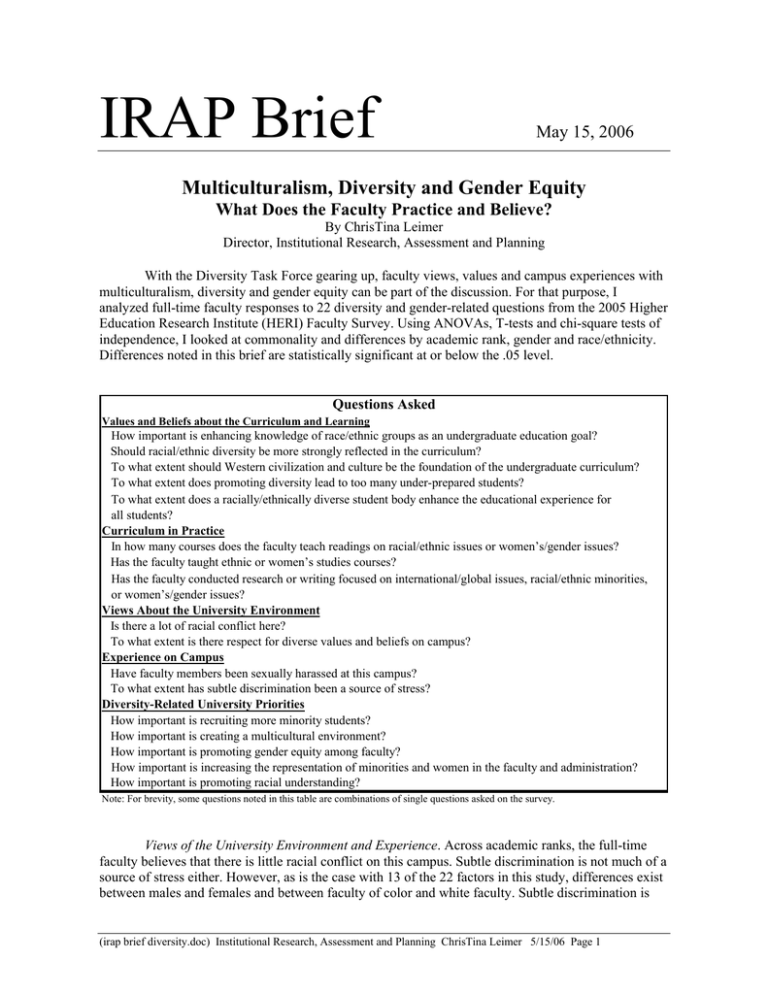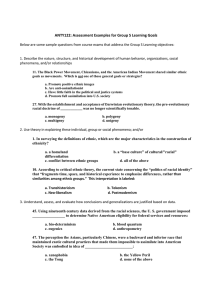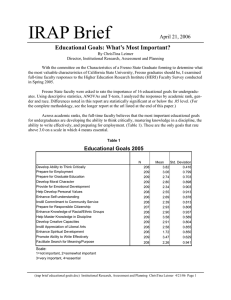IRAP Brief Multiculturalism, Diversity and Gender Equity May 15, 2006
advertisement

IRAP Brief May 15, 2006 Multiculturalism, Diversity and Gender Equity What Does the Faculty Practice and Believe? By ChrisTina Leimer Director, Institutional Research, Assessment and Planning With the Diversity Task Force gearing up, faculty views, values and campus experiences with multiculturalism, diversity and gender equity can be part of the discussion. For that purpose, I analyzed full-time faculty responses to 22 diversity and gender-related questions from the 2005 Higher Education Research Institute (HERI) Faculty Survey. Using ANOVAs, T-tests and chi-square tests of independence, I looked at commonality and differences by academic rank, gender and race/ethnicity. Differences noted in this brief are statistically significant at or below the .05 level. Questions Asked Values and Beliefs about the Curriculum and Learning How important is enhancing knowledge of race/ethnic groups as an undergraduate education goal? Should racial/ethnic diversity be more strongly reflected in the curriculum? To what extent should Western civilization and culture be the foundation of the undergraduate curriculum? To what extent does promoting diversity lead to too many under-prepared students? To what extent does a racially/ethnically diverse student body enhance the educational experience for all students? Curriculum in Practice In how many courses does the faculty teach readings on racial/ethnic issues or women’s/gender issues? Has the faculty taught ethnic or women’s studies courses? Has the faculty conducted research or writing focused on international/global issues, racial/ethnic minorities, or women’s/gender issues? Views About the University Environment Is there a lot of racial conflict here? To what extent is there respect for diverse values and beliefs on campus? Experience on Campus Have faculty members been sexually harassed at this campus? To what extent has subtle discrimination been a source of stress? Diversity-Related University Priorities How important is recruiting more minority students? How important is creating a multicultural environment? How important is promoting gender equity among faculty? How important is increasing the representation of minorities and women in the faculty and administration? How important is promoting racial understanding? Note: For brevity, some questions noted in this table are combinations of single questions asked on the survey. Views of the University Environment and Experience. Across academic ranks, the full-time faculty believes that there is little racial conflict on this campus. Subtle discrimination is not much of a source of stress either. However, as is the case with 13 of the 22 factors in this study, differences exist between males and females and between faculty of color and white faculty. Subtle discrimination is (irap brief diversity.doc) Institutional Research, Assessment and Planning ChrisTina Leimer 5/15/06 Page 1 more stressful for women and faculty of color than it is for men and white faculty. More women than men have been sexually harassed. Faculty of color say racial conflict on campus is more prevalent than white faculty say it is. Scholarly Activity. Survey results show that 23% of the full-time faculty has conducted research or written about racial/ethnic minority issues. Sixteen percent have written about or researched women’s or gender issues. This is comparable to full-time faculty at other four-year colleges and universities. As for teaching, 6.2% have taught women’s studies and 8.4% have taught ethnic studies. These percentages too are comparable to those at other universities and colleges. Again, differences by sex and race/ethnicity arise when looking at who is teaching, researching and writing about diversity and gender issues. Faculty of color are more likely than white faculty to have taught ethnic studies courses. More women than men have taught women’s studies courses and conducted research or written about women’s/gender issues. In addition, women are likely to have included readings on racial/ethnic issues and women’s/gender issues in more of their courses than men have. Approximately 25% of full-time faculty members have researched or written about global/international issues as have faculty at other four-year colleges and universities. On this factor, there are no differences by race/ethnicity or gender. There is, however, a difference by academic rank. Associate Professors are more likely to conduct research or write about international/global issues than are the other academic ranks (43% of Associates, 27% Assistants, 24% Full Professors, 11% Lecturers). Curriculum. Differences exist in what faculty members believe about the curriculum. Assistant Professors have a greater belief than Professors that diversity should be more strongly reflected in the curriculum. Faculty of color believe this to a greater degree than white faculty do. Professors believe more strongly than Associate and Assistant Professors that Western civilization and culture should be the foundation of the curriculum. Male faculty members are more supportive of this Western culture orientation than are female faculty members. Faculty of color and women consider enhancing knowledge of racial/ethnic groups to be a more important undergraduate educational goal than white faculty and men do. The highest rated issue overall is the belief that a diverse student body enhances the educational experience for all students. Faculty rated this 3.39 on a 4-point scale. Faculty of color and women rated it even higher (3.56 and 3.52, respectively), higher than white faculty and men did (3.33 and 3.31, respectively). Given these distinctions, it may be no surprise to learn that it is more “personally” important to women and faculty of color than to men and white faculty to promote racial understanding. ### See the full report that includes the methodology and data tables at the IRAP website: csufresno.edu/ir/data_research/reports_studies.shtml (irap brief diversity.doc) Institutional Research, Assessment and Planning ChrisTina Leimer 5/15/06 Page 2






